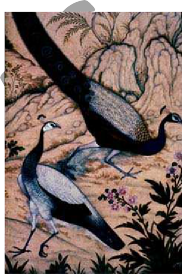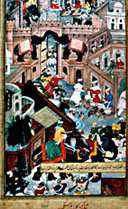11.3 Mughal Painting
Mughal painting is a particular style of Indian painting, generally confined to illustrations on the book and done in miniatures, and which emerged, developed and took shape during the period of the Mughal Empire 16th −19th centuries.

Mughal paintings were a unique blend of Indian, Persian and Islamic styles. Because the Mughal kings wanted visual records of their deeds as hunters and
conquerors, their artists accompanied them on military expeditions or missions of state, or recorded their prowess as animal slayers, or depicted them in the great dynastic ceremonies of marriages.
Akbar's reign (1556–1605) ushered a new era in Indian miniature painting. After he had consolidated his political power, he built a new capital at Fatehpur Sikri where he collected artists from India and Persia. He was the first morarch who established in India an atelier under the supervision of two Persian master artists, Mir Sayyed Ali and Abdus Samad. Earlier, both of them had served under the patronage of Humayun in Kabul and accompanied him to India when he regained his throne in 1555. More than a hundred painters were employed,
most of whom were Hindus from Gujarat, Gwalior and Kashmir, who gave a birth to a new school of painting, popularly known as the Mughal School of miniature Paintings.

One of the first productions of that school of miniature painting was the Hamzanama series, which according to the court historian, Badayuni, was started in 1567
and completed in 1582. TheHamzanama, stories of Amir Hamza, an uncle of the Prophet, were illustrated by Mir Sayyid Ali. The paintings of the Hamzanama are of large size, 20 x 27" and were painted on cloth. They are in the Persian safavi style. Brilliant red, blue and green colours predominate; the pink, eroded rocks and the vegetation, planes and blossoming plum and peach trees are reminiscent of Persia. However, Indian tones appear in later work, when Indian artists were employed.
After him, Jahangir encouraged artists to paint portraits and durbar scenes. His most talented portrait painters were Ustad Mansur, Abul Hasan and Bishandas.
Shah Jahan (1627–1658) continued the patronage of painting. Some of the famous artists of the period were Mohammad Faqirullah Khan, Mir Hashim, Muhammad Nadir, Bichitr, Chitarman, Anupchhatar, Manohar and Honhar.Aurangzeb had no taste for fine arts. Due to lack of patronage artists migrated to Hyderabad in the Deccan and to the Hindu states of Rajasthan in search of new patrons.
